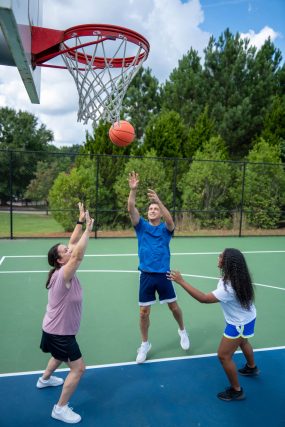Tips to Support Healthy Routines for Children and Teens
Healthy habits are the building blocks of lifelong well-being for children and teens. Healthy eating and physical activity are important for growth and development and to prevent chronic health conditions. They can also help boost students’ academic performance.
But eating well and being active are only part of the picture. For good mental and physical health, kids also need plenty of sleep and limited screen time.
Parents, guardians, and teachers can help children and teens develop healthy habits with these tips:
Ensure adequate sleep
Children and teens need more sleep than adults, and the amount varies by age. Too little sleep is associated with obesity, partly because inadequate sleep may make us eat more and be less physically active. See the recommended amounts of sleep by age and suggested habits to improve sleep.
Reduce screen time
In young people, too much screen time is associated with poor sleep, weight gain, lower grades in school, and poor mental health. Reducing screen time can help free up time for individual and family activities, improve sleep, and limit cues to eat unhealthy food.
Limit the time children and teens watch television, play video games, or using a smartphone or tablet. Instead, encourage children and teens to find fun activities to do with their friends and family members or on their own that involve more activity. See the Screen Time Vs Lean Time.
Develop healthy eating habits

To help children and teens develop healthy eating habits:
- Provide plenty of vegetables, fruits, and whole-grain products.
- Choose lean meats, poultry, fish, lentils, and beans for protein.
- Include low-fat or non-fat milk or dairy products, such as cheese and yogurt.
- Encourage your family to drink water instead of sugary drinks.
- Limit added sugar and saturated fat. [PDF-754KB]
Additionally, you can:
- Encourage kids to eat a healthy breakfast and lunch whether at home or at school.
- Review school menus with your kids and encourage them to try new foods.
- Model healthy eating at home.
Remember that small changes every day can lead to success!
For more information about nutrition, visit Choose My Plate for children and the Dietary Guidelines for Americans [PDF-30.6MB].
Limit snacks with lots of salt, added sugar, and saturated fat

Limiting snacks with high amounts of saturated fat, added sugar, and salt can help support healthy eating habits. If these foods are eaten less often, they will truly be treats! For everyday snacks, try these easy-to-prepare options.
- 1 cup carrots, broccoli, or bell peppers with 2 tablespoons hummus.
- A medium apple or banana with 1 tablespoon peanut butter.
- 1 cup blueberries or grapes with 1/2 cup plain, low-fat yogurt.
- One-fourth cup of tuna wrapped in a lettuce leaf.
Help children and teens stay active

In addition to being fun, regular physical activity has many health benefits, including:
- Strengthening bones and muscles.
- Decreasing blood pressure.
- Reducing risk of several chronic diseases, including type 2 diabetes and obesity.
- Reducing risk of depression.
- Boosting academic performance by improving attention and memory.
- Helping regulate body weight and reduce body fat.
Children ages 3 through 5 should be active throughout the day. Children and adolescents ages 6 through 17 should be physically active at least 60 minutes each day. Include aerobic activity, which is anything that makes their heart beat faster. Also, include bone-strengthening activities such as running or jumping and muscle-strengthening activities such as climbing or push-ups. See details.
To help children and teens get enough physical activity:
- Make physical activity part of your family’s daily routine by taking walks or playing active games together.
- Encourage children and teens to find fun activities to do on their own or with friends and family, such as walking or riding bikes.
- Take young people to places where they can be active, such as public parks or playgrounds, community baseball fields, or community basketball courts.
- Encourage your child to participate in school or community physical activity or sports programs.
Remember that children imitate adults. Start adding physical activity to your own routine and encourage your child to join you.
Healthy Eating
- Infographic: The Benefits of Healthy Eating for Children
- Healthy Eating Tips – Choosing healthy foods and drinks.
- Healthy Growth and Brain Development – Learn how to include a variety of fruits and vegetables in your child’s diet.
- My Plate Kids Place – Includes games, activity sheets, videos, and songs.
Physical Activity
- Infographic: Health Benefits of Physical Activity for Children
- Physical Activity for Everyone – Physical activity recommendations by age.
- Tips for Getting More Active Minutes – Easy ways to find more time for physical activity.
- Best Bones Forever! – Children learn why calcium, vitamin D, and bone-strengthening activity are essential.
- Infographic: Benefits of School-Based Physical Activity – How 60 minutes of daily moderate-to-vigorous physical activity can benefit a student’s health and directly impact teachers and the community.
Social and Emotional Wellness
- BAM! Body and Mind – Classroom resources for teachers of grades 4 through 8 to help students make healthier lifestyle choices.
- Give Your Kids a Healthy Body and Mind This Summer – Learn ways to support your child’s physical and emotional well-being.
- Parents for Healthy Schools – Resources to encourage parent involvement in school health.
Maintaining a Healthy Weight
- Preventing Childhood Obesity – Four things you can do at home.
- Child and Teen BMI (Body Mass Index) Calculator – For children, BMI screens for obesity, but it is not a diagnostic tool. See more about BMI for children and teens.
- Childhood Overweight and Obesity – How obesity is defined for children, prevalence, associated factors, and related health consequences.
- We Can! – National education program designed for adults to help children 8- to 13-years-old stay at a healthy weight.
